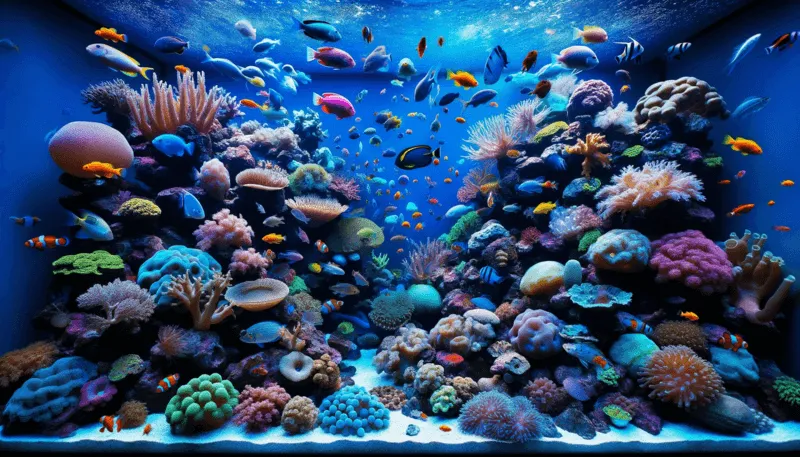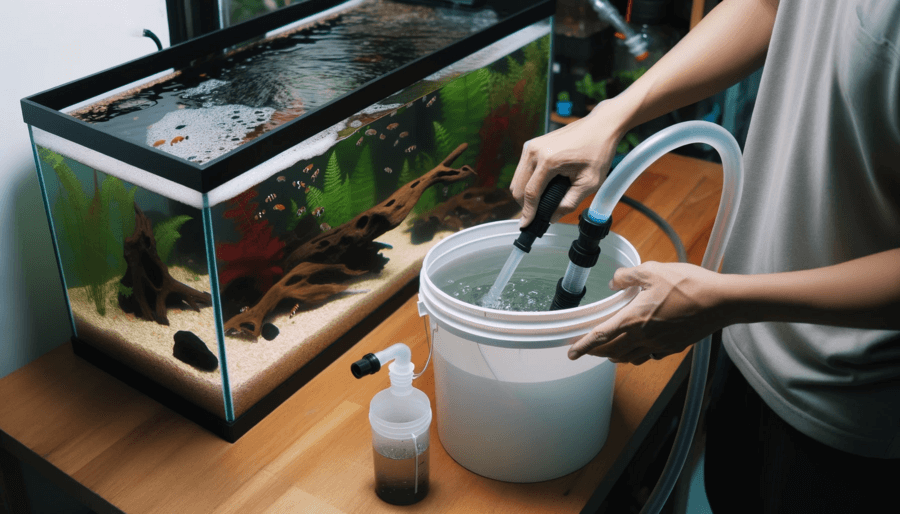Can I Keep Saltwater And Freshwater Fish Together?

Thinking about starting your own fish tank? The thought of colorful saltwater and freshwater fish swimming harmoniously together is certainly an appealing concept. However, before you rush off to the pet store to stock up on fish, it’s important to consider whether or not it’s actually possible to keep these two types of fish in one tank. In this article, we will explore the compatibility of saltwater and freshwater fish and provide helpful insights to ensure a successful and thriving aquarium environment. So, let’s dive right in and discover if you can keep saltwater and freshwater fish together!
Factors to Consider Before Mixing Saltwater and Freshwater Fish
Temperature Tolerance
Before considering mixing saltwater and freshwater fish, it is important to assess the temperature tolerance of the species you intend to keep. While saltwater fish generally thrive in warmer water, ranging from 75 to 82 degrees Fahrenheit, many freshwater species prefer cooler temperatures, typically between 68 to 78 degrees Fahrenheit. Therefore, it is crucial to choose species that can adapt to a suitable temperature range that accommodates both types of fish.
pH Levels
pH levels play a significant role in maintaining the health and well-being of fish. Saltwater fish usually require a more alkaline environment with pH levels ranging from 8.1 to 8.4, while freshwater species tend to thrive in a slightly acidic environment with pH levels between 6.5 and 7.5. Therefore, finding a balance and maintaining a stable pH that accommodates both freshwater and saltwater fish is essential.
Salinity
The salinity of the water is another important factor to consider when mixing saltwater and freshwater fish. Saltwater fish, as the name suggests, require water with a higher salt concentration. The ideal salinity for saltwater fish is around 35 parts per thousand (ppt). On the other hand, freshwater fish thrive in a salinity level of 0 ppt. It is crucial to find a balance that suits both types of fish by creating a brackish water environment with a lower salinity level.
Compatibility of Species
One of the most crucial factors to consider before mixing saltwater and freshwater fish is the compatibility of the species. Different fish species have different temperaments and behavioral traits, which may lead to aggressive interactions or even predation. It is essential to research and choose species that have compatible behaviors and are less likely to harm each other. Additionally, it is advisable to introduce peaceful and sociable species to minimize the risk of aggression.
Setting Up the Aquarium for Mixing Saltwater and Freshwater Fish
Choosing the Right Tank Size
When setting up an aquarium for mixing saltwater and freshwater fish, selecting the appropriate tank size is vital. The tank needs to be spacious enough to cater to the requirements of both types of fish comfortably. Each fish species has its own space requirements and swimming habits, so it is necessary to consider these factors when determining the tank size. A larger tank with ample swimming space will help reduce stress and promote a healthier environment for the fish.
Creating Separate Environments within the Tank
To successfully house saltwater and freshwater fish together, it is crucial to create separate environments within the tank. This can be achieved by utilizing physical barriers such as rocks, caves, or plants to divide the tank and create distinct areas for each species. This separation allows the fish to establish their territories and reduces the possibility of aggressive encounters. Additionally, it provides the necessary environmental conditions for each type of fish, such as specific water parameters and decorations.
Installing Appropriate Filtration Systems
Adequate filtration is essential for maintaining water quality in an aquarium housing both saltwater and freshwater fish. Different species produce varying amounts of waste, and the filtration system needs to accommodate the needs of both types of fish. A high-quality filtration system with multiple stages, including mechanical, biological, and chemical filtration, can help eliminate toxins, control ammonia and nitrate levels, and provide optimal water conditions for the mixed fish species. Regular maintenance and monitoring of the filtration system are necessary to ensure its effectiveness.
Transition Period for Mixing Saltwater and Freshwater Fish
Gradual Acclimation Process
When introducing saltwater and freshwater fish together, it is crucial to allow for a gradual acclimation process. Sudden changes in water parameters, such as salinity, temperature, and pH, can cause stress, shock, and even mortality for the fish. To minimize these risks, it is recommended to acclimate the fish slowly by gradually adjusting the water parameters over a period of time. This can be done by adding small amounts of saltwater or freshwater to the tank at regular intervals, allowing the fish to adapt to the changing conditions.
Monitoring Water Parameters
Regular monitoring of water parameters is essential during the transition period and throughout the life of the mixed aquarium. It is important to keep a close eye on salinity, temperature, pH levels, and ammonia, nitrite, and nitrate levels. Any significant fluctuations or abnormalities should be addressed promptly to maintain a stable and healthy environment for all the fish. Inaccurate or inconsistent water parameters can lead to stress, disease, or even fatalities, so diligent monitoring is key to ensuring the well-being of the mixed fish community.
Stress Reduction Techniques
During the transition period, stress reduction techniques can play a significant role in helping the fish adapt to their new environment. Providing ample hiding places, such as caves, plants, or rocks, can help reduce stress by offering security and privacy for the fish. Additionally, it is advisable to maintain consistent feeding routines and provide a nutritionally balanced diet to ensure the fish receive proper nourishment. Ensuring the fish have access to natural sunlight or appropriate lighting can also aid in reducing stress levels.
Common Mistakes to Avoid When Mixing Saltwater and Freshwater Fish
Incorrect Salinity Levels
One common mistake when mixing saltwater and freshwater fish is maintaining incorrect salinity levels. It is crucial to create a brackish water environment with a salinity level that suits both types of fish. Neglecting to achieve the right balance can result in stress, health issues, or even death for the fish. Regularly testing and adjusting the salinity levels to maintain the optimal range is essential to ensure the well-being of all the fish in the mixed aquarium.
Incompatible Tankmates
Another common mistake is selecting incompatible tankmates when mixing saltwater and freshwater fish. Fish with aggressive or territorial behavior may pose a threat to more peaceful species, leading to constant stress, injuries, or fatalities. It is important to research and choose species that have compatible temperaments and behaviors to minimize the risk of aggression or predation. Consulting with experienced aquarists or seeking professional advice can significantly help in selecting suitable tankmates for the mixed aquarium.
Neglecting Water Maintenance
Neglecting water maintenance is a common mistake that can have severe consequences when mixing saltwater and freshwater fish. Proper water quality is vital for the health and survival of all fish species. Failing to regularly test and maintain appropriate levels of ammonia, nitrite, nitrate, pH, and temperature can result in stress, disease outbreaks, or even fish fatalities. Regular water changes, filter maintenance, and diligent monitoring of water parameters are necessary to ensure a healthy and stable environment for all the fish.
Species Recommendations for Mixing Saltwater and Freshwater Fish
Brackish Water Fish
A great option for mixed aquariums is choosing brackish water fish. These species are naturally adapted to thrive in environments with varying levels of salinity. Some popular brackish water fish include mollies, archerfish, and scats. These species can tolerate a wide range of salinity levels and can coexist well with both saltwater and freshwater fish.
Hardy Freshwater Species
Hardy freshwater species are another suitable choice for mixed aquariums. These fish can adapt to a range of water conditions and are generally more resilient when it comes to fluctuating parameters. Species such as guppies, tetras, and danios are known for their adaptability and compatibility with both fresh and brackish water fish.
Adapted Saltwater Species
Certain saltwater species are also adaptable enough to thrive in mixed aquariums. Green chromis, bumblebee gobies, and some species of damselfish are known to tolerate lower salinity levels and can coexist with compatible freshwater fish. However, it is important to research and select saltwater species that can adapt well to the specific conditions of a mixed aquarium.
Benefits and Drawbacks of Mixing Saltwater and Freshwater Fish
Adding Variety to the Aquarium
One of the main benefits of mixing saltwater and freshwater fish is the opportunity to add a diverse range of species to the aquarium. This combination allows for a visually striking display with fish of different colors, shapes, and sizes. The contrasting behaviors and swimming patterns of saltwater and freshwater fish can create a dynamic and captivating underwater environment.
Higher Maintenance and Care Requirements
Mixing saltwater and freshwater fish, however, comes with higher maintenance and care requirements. The need to maintain appropriate salinity, temperature, and water quality for both types of fish can be more demanding than caring for a single-species aquarium. Regular testing, monitoring, and adjustments may be necessary to ensure optimal conditions for the mixed fish community. This increased maintenance effort is essential to promote the overall health and longevity of the fish in the aquarium.
Increased Risk of Disease Transmission
Another drawback to consider when mixing saltwater and freshwater fish is the increased risk of disease transmission. Different fish species may have varying levels of resistance to certain pathogens or parasites. Introducing new species to an existing mixed community can potentially introduce new diseases or stress that may affect the entire tank. Quarantine protocols, regular observation, and appropriate fish selection can help minimize this risk, but it is an important factor to be aware of.
Tips for Successfully Keeping Saltwater and Freshwater Fish Together
Researching Species Compatibility
Thoroughly researching and understanding the compatibility of different fish species is crucial when planning to mix saltwater and freshwater fish. Make sure to consider factors such as temperament, size, feeding habits, and water parameter requirements. Taking the time to choose compatible species will help promote a harmonious and thriving mixed aquarium.
Regular Water Testing and Maintenance
Maintaining optimal water conditions is essential for the health and well-being of all fish in a mixed aquarium. Regularly test water parameters such as temperature, pH levels, ammonia, nitrite, and nitrate levels. Perform routine water changes and clean the filtration system as needed to ensure a clean and stable environment for the fish.
Observing Fish Behavior
Closely observing fish behavior on a regular basis is an important practice in a mixed aquarium. Note any signs of stress, aggression, or unusual behavior displayed by individual fish. Early detection of any problems can help address and resolve issues before they escalate and impact the entire fish community.
Conclusion
Before deciding to mix saltwater and freshwater fish in a single aquarium, it is crucial to carefully consider the various factors involved. Temperature tolerance, pH levels, salinity, and the compatibility of species play key roles in ensuring the well-being of all fish. Setting up the aquarium with the right tank size, separate environments, and appropriate filtration systems is essential. The transition period requires gradual acclimation, monitoring of water parameters, and stress reduction techniques. Avoiding common mistakes such as incorrect salinity levels, choosing incompatible tankmates, and neglecting water maintenance is vital for the success of a mixed aquarium. Species recommendations include brackish water fish, hardy freshwater species, and adapted saltwater species. Mixing saltwater and freshwater fish introduces variety to the aquarium but requires higher maintenance and care requirements, as well as an increased risk of disease transmission. Tips for successfully keeping saltwater and freshwater fish together involve researching species compatibility, regular water testing and maintenance, and observing fish behavior. Ultimately, assessing one’s own experience and capability is crucial in determining whether mixing saltwater and freshwater fish is the right choice for your aquarium.
